Solution of triangles ( la, solutio triangulorum) is the main
trigonometric
Trigonometry () is a branch of mathematics that studies relationships between side lengths and angles of triangles. The field emerged in the Hellenistic world during the 3rd century BC from applications of geometry to astronomical studies. ...
problem of finding the characteristics of a
triangle
A triangle is a polygon with three edges and three vertices. It is one of the basic shapes in geometry. A triangle with vertices ''A'', ''B'', and ''C'' is denoted \triangle ABC.
In Euclidean geometry, any three points, when non-collinear ...
(angles and lengths of sides), when some of these are known. The triangle can be located on a
plane
Plane(s) most often refers to:
* Aero- or airplane, a powered, fixed-wing aircraft
* Plane (geometry), a flat, 2-dimensional surface
Plane or planes may also refer to:
Biology
* Plane (tree) or ''Platanus'', wetland native plant
* ''Planes' ...
or on a
sphere
A sphere () is a geometrical object that is a three-dimensional analogue to a two-dimensional circle. A sphere is the set of points that are all at the same distance from a given point in three-dimensional space.. That given point is the ...
. Applications requiring triangle solutions include
geodesy
Geodesy ( ) is the Earth science of accurately measuring and understanding Earth's figure (geometric shape and size), Earth rotation, orientation in space, and Earth's gravity, gravity. The field also incorporates studies of how these properti ...
,
astronomy
Astronomy () is a natural science that studies celestial objects and phenomena. It uses mathematics, physics, and chemistry in order to explain their origin and evolution. Objects of interest include planets, moons, stars, nebulae, galax ...
,
construction, and
navigation
Navigation is a field of study that focuses on the process of monitoring and controlling the movement of a craft or vehicle from one place to another.Bowditch, 2003:799. The field of navigation includes four general categories: land navigation, ...
.
Solving plane triangles

A general form triangle has six main characteristics (see picture): three linear (side lengths ) and three angular (). The classical plane trigonometry problem is to specify three of the six characteristics and determine the other three. A triangle can be uniquely determined in this sense when given any of the following:
*Three sides (SSS)
*Two sides and the included angle (SAS)
*Two sides and an angle not included between them (SSA), if the side length adjacent to the angle is shorter than the other side length.
*A side and the two angles adjacent to it (ASA)
*A side, the angle opposite to it and an angle adjacent to it (AAS).
For all cases in the plane, at least one of the side lengths must be specified. If only the angles are given, the side lengths cannot be determined, because any
similar triangle is a solution.
Trigonomic relations
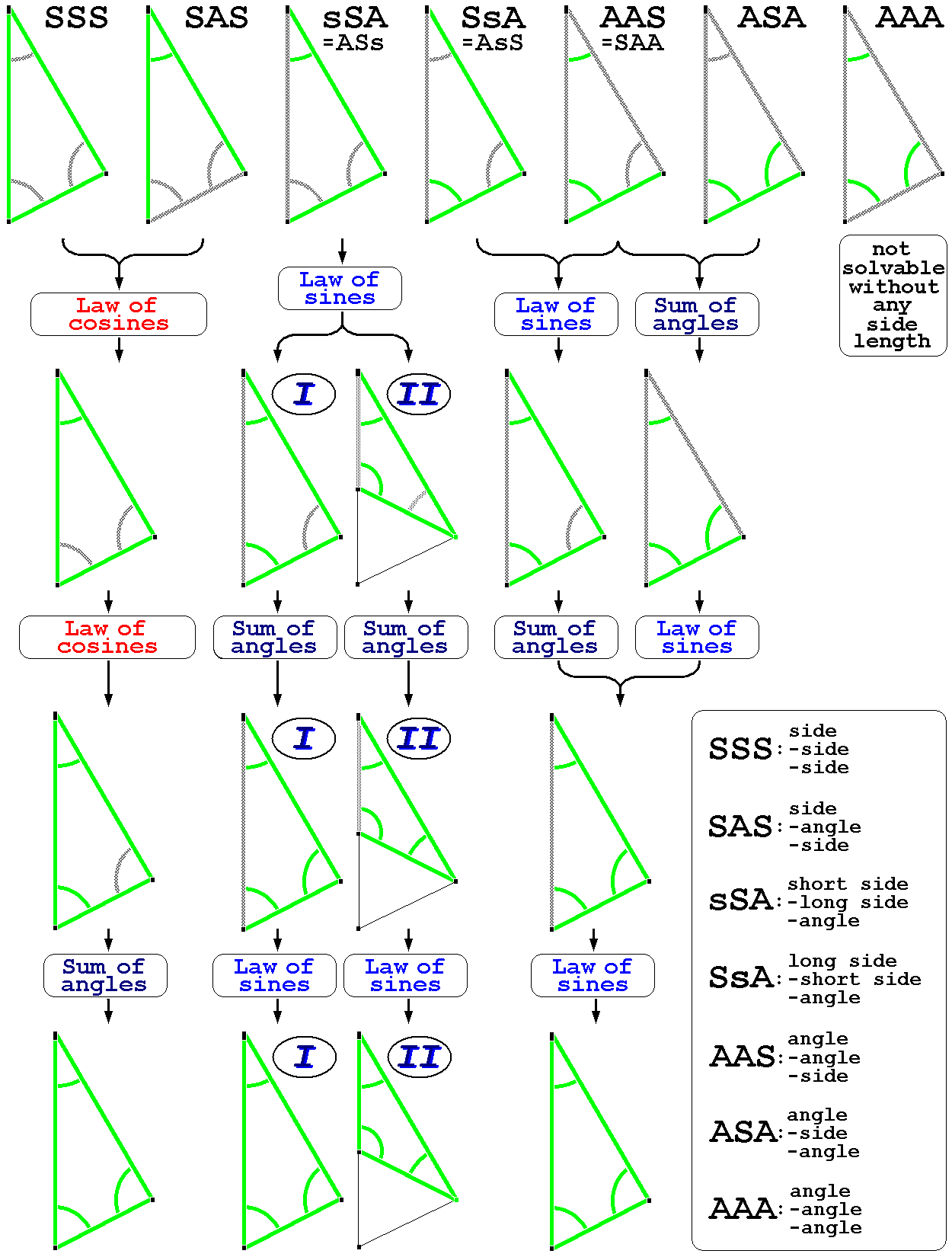
The standard method of solving the problem is to use fundamental relations.
;
Law of cosines
In trigonometry, the law of cosines (also known as the cosine formula, cosine rule, or al-Kashi's theorem) relates the lengths of the sides of a triangle to the cosine of one of its angles. Using notation as in Fig. 1, the law of cosines state ...
:
:
:
;
Law of sines
In trigonometry, the law of sines, sine law, sine formula, or sine rule is an equation relating the lengths of the sides of any triangle to the sines of its angles. According to the law,
\frac \,=\, \frac \,=\, \frac \,=\, 2R,
where , and ar ...
:
;
Sum of angles:
:
;
Law of tangents
In trigonometry, the law of tangents is a statement about the relationship between the tangents of two angles of a triangle and the lengths of the opposing sides.
In Figure 1, , , and are the lengths of the three sides of the triangle, and , , ...
:
There are other (sometimes practically useful) universal relations: the
law of cotangents
In trigonometry, the law of cotangentsThe Universal Encyclopaedia of Mathematics, Pan Reference Books, 1976, page 530. English version George Allen and Unwin, 1964. Translated from the German version Meyers Rechenduden, 1960. is a relationship am ...
and
Mollweide's formula
In trigonometry, Mollweide's formula is a pair of relationships between sides and angles in a triangle.
A variant in more geometrical style was first published by Isaac Newton in 1707 and then by in 1746. Thomas Simpson published the now-standar ...
.
Notes
#To find an unknown angle, the
law of cosines
In trigonometry, the law of cosines (also known as the cosine formula, cosine rule, or al-Kashi's theorem) relates the lengths of the sides of a triangle to the cosine of one of its angles. Using notation as in Fig. 1, the law of cosines state ...
is safer than the
law of sines
In trigonometry, the law of sines, sine law, sine formula, or sine rule is an equation relating the lengths of the sides of any triangle to the sines of its angles. According to the law,
\frac \,=\, \frac \,=\, \frac \,=\, 2R,
where , and ar ...
. The reason is that the value of
sine
In mathematics, sine and cosine are trigonometric functions of an angle. The sine and cosine of an acute angle are defined in the context of a right triangle: for the specified angle, its sine is the ratio of the length of the side that is op ...
for the angle of the triangle does not uniquely determine this angle. For example, if , the angle can equal either 30° or 150°. Using the law of cosines avoids this problem: within the interval from 0° to 180° the cosine value unambiguously determines its angle. On the other hand, if the angle is small (or close to 180°), then it is more robust numerically to determine it from its sine than its cosine because the arc-cosine function has a divergent derivative at 1 (or −1).
#We assume that the relative position of specified characteristics is known. If not, the mirror reflection of the triangle will also be a solution. For example, three side lengths uniquely define either a triangle or its reflection.
Three sides given (SSS)
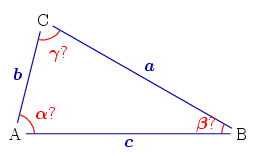
Let three side lengths be specified. To find the angles , the
law of cosines
In trigonometry, the law of cosines (also known as the cosine formula, cosine rule, or al-Kashi's theorem) relates the lengths of the sides of a triangle to the cosine of one of its angles. Using notation as in Fig. 1, the law of cosines state ...
can be used:
:
Then angle .
Some sources recommend to find angle from the
law of sines
In trigonometry, the law of sines, sine law, sine formula, or sine rule is an equation relating the lengths of the sides of any triangle to the sines of its angles. According to the law,
\frac \,=\, \frac \,=\, \frac \,=\, 2R,
where , and ar ...
but (as Note 1 above states) there is a risk of confusing an acute angle value with an obtuse one.
Another method of calculating the angles from known sides is to apply the
law of cotangents
In trigonometry, the law of cotangentsThe Universal Encyclopaedia of Mathematics, Pan Reference Books, 1976, page 530. English version George Allen and Unwin, 1964. Translated from the German version Meyers Rechenduden, 1960. is a relationship am ...
.
Two sides and the included angle given (SAS)

Here the lengths of sides and the angle between these sides are known. The third side can be determined from the law of cosines:
:
Now we use law of cosines to find the second angle:
:
Finally, .
Two sides and non-included angle given (SSA)


This case is not solvable in all cases; a solution is guaranteed to be unique only if the side length adjacent to the angle is shorter than the other side length. Assume that two sides and the angle are known. The equation for the angle can be implied from the
law of sines
In trigonometry, the law of sines, sine law, sine formula, or sine rule is an equation relating the lengths of the sides of any triangle to the sines of its angles. According to the law,
\frac \,=\, \frac \,=\, \frac \,=\, 2R,
where , and ar ...
:
:
We denote further (the equation's right side). There are four possible cases:
#If , no such triangle exists because the side does not reach line . For the same reason a solution does not exist if the angle and .
#If , a unique solution exists: , i.e., the triangle is
right-angled.
# If two alternatives are possible.
## If , then (the larger side corresponds to a larger angle). Since no triangle can have two obtuse angles, is an acute angle and the solution is unique.
## If , the angle may be acute: or obtuse: . The figure on right shows the point , the side and the angle as the first solution, and the point , side and the angle as the second solution.
Once is obtained, the third angle .
The third side can then be found from the law of sines:
:
or from the law of cosines:
:
A side and two adjacent angles given (ASA)
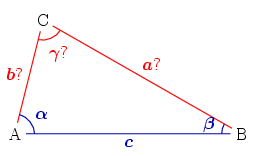
The known characteristics are the side and the angles . The third angle .
Two unknown sides can be calculated from the law of sines:
:
or
:
:
A side, one adjacent angle and the opposite angle given (AAS)
The procedure for solving an AAS triangle is same as that for an ASA triangle: First, find the third angle by using the angle sum property of a triangle, then find the other two sides using the
law of sines
In trigonometry, the law of sines, sine law, sine formula, or sine rule is an equation relating the lengths of the sides of any triangle to the sines of its angles. According to the law,
\frac \,=\, \frac \,=\, \frac \,=\, 2R,
where , and ar ...
.
Other given lengths
In many cases, triangles can be solved given three pieces of information some of which are the lengths of the triangle's
medians
The Medes (Old Persian: ; Akkadian: , ; Ancient Greek: ; Latin: ) were an ancient Iranian people who spoke the Median language and who inhabited an area known as Media between western and northern Iran. Around the 11th century BC, the ...
,
altitudes
Altitude or height (also sometimes known as depth) is a distance measurement, usually in the vertical or "up" direction, between a reference datum and a point or object. The exact definition and reference datum varies according to the context ...
, or
angle bisector
In geometry, bisection is the division of something into two equal or congruent parts, usually by a line, which is then called a ''bisector''. The most often considered types of bisectors are the ''segment bisector'' (a line that passes through ...
s. Posamentier and Lehmann list the results for the question of solvability using no higher than square roots (i.e.,
constructibility) for each of the 95 distinct cases; 63 of these are constructible.
Solving spherical triangles

The general
spherical triangle
Spherical trigonometry is the branch of spherical geometry that deals with the metrical relationships between the sides and angles of spherical triangles, traditionally expressed using trigonometric functions. On the sphere, geodesics are g ...
is fully determined by three of its six characteristics (3 sides and 3 angles). The lengths of the sides of a spherical triangle are their
central angle
A central angle is an angle whose apex (vertex) is the center O of a circle and whose legs (sides) are radii intersecting the circle in two distinct points A and B. Central angles are subtended by an arc between those two points, and the arc l ...
s, measured in angular units rather than linear units. (On a unit sphere, the angle (in
radians
The radian, denoted by the symbol rad, is the unit of angle in the International System of Units (SI) and is the standard unit of angular measure used in many areas of mathematics. The unit was formerly an SI supplementary unit (before that c ...
) and length around the sphere are numerically the same. On other spheres, the angle (in radians) is equal to the length around the sphere divided by the radius.)
Spherical geometry
300px, A sphere with a spherical triangle on it.
Spherical geometry is the geometry of the two-dimensional surface of a sphere. In this context the word "sphere" refers only to the 2-dimensional surface and other terms like "ball" or "solid sp ...
differs from planar
Euclidean geometry
Euclidean geometry is a mathematical system attributed to ancient Greek mathematician Euclid, which he described in his textbook on geometry: the ''Elements''. Euclid's approach consists in assuming a small set of intuitively appealing axioms ...
, so the solution of spherical triangles is built on different rules. For example, the
sum of the three angles depends on the size of the triangle. In addition,
similar triangles
In Euclidean geometry, two objects are similar if they have the same shape, or one has the same shape as the mirror image of the other. More precisely, one can be obtained from the other by uniformly scaling (enlarging or reducing), possibly wit ...
cannot be unequal, so the problem of constructing a triangle with specified three angles has a unique solution. The basic relations used to solve a problem are similar to those of the planar case: see
Spherical law of cosines In spherical trigonometry, the law of cosines (also called the cosine rule for sides) is a theorem relating the sides and angles of spherical triangles, analogous to the ordinary law of cosines from plane trigonometry.
Given a unit sphere, a "sphe ...
and
Spherical law of sines
In trigonometry, the law of sines, sine law, sine formula, or sine rule is an equation relating the lengths of the sides of any triangle to the sines of its angles. According to the law,
\frac \,=\, \frac \,=\, \frac \,=\, 2R,
where , and ar ...
.
Among other relationships that may be useful are the
half-side formula
In spherical trigonometry, the half side formula relates the angles and lengths of the sides of spherical triangles, which are triangles drawn on the surface of a sphere and so have curved sides and do not obey the formulas for plane triangles.
Fo ...
and
Napier's analogies
Spherical trigonometry is the branch of spherical geometry that deals with the metrical relationships between the sides and angles of spherical triangles, traditionally expressed using trigonometric functions. On the sphere, geodesics are gre ...
:
Napier's Analogies
at MathWorld
*
*
*
*

Three sides given (spherical SSS)
Known: the sides (in angular units). The triangle's angles are computed using the spherical law of cosines In spherical trigonometry, the law of cosines (also called the cosine rule for sides) is a theorem relating the sides and angles of spherical triangles, analogous to the ordinary law of cosines from plane trigonometry.
Given a unit sphere, a "sphe ...
:
:
:
:
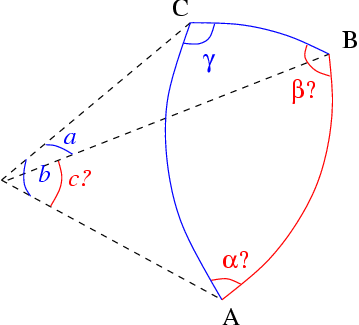
Two sides and the included angle given (spherical SAS)
Known: the sides and the angle between them. The side can be found from the spherical law of cosines:
:
The angles can be calculated as above, or by using Napier's analogies:
:
:
This problem arises in the navigation problem of finding the great circle between two points on the earth specified by their latitude and longitude; in this application, it is important to use formulas which are not susceptible to round-off errors. For this purpose, the following formulas (which may be derived using vector algebra) can be used:
:
where the signs of the numerators and denominators in these expressions should be used to determine the quadrant of the arctangent.

Two sides and non-included angle given (spherical SSA)
This problem is not solvable in all cases; a solution is guaranteed to be unique only if the side length adjacent to the angle is shorter than the other side length. Known: the sides and the angle not between them. A solution exists if the following condition holds:
:
The angle can be found from the spherical law of sines
In trigonometry, the law of sines, sine law, sine formula, or sine rule is an equation relating the lengths of the sides of any triangle to the sines of its angles. According to the law,
\frac \,=\, \frac \,=\, \frac \,=\, 2R,
where , and ar ...
:
:
As for the plane case, if then there are two solutions: and .
We can find other characteristics by using Napier's analogies:
:

A side and two adjacent angles given (spherical ASA)
Known: the side and the angles . First we determine the angle using the spherical law of cosines In spherical trigonometry, the law of cosines (also called the cosine rule for sides) is a theorem relating the sides and angles of spherical triangles, analogous to the ordinary law of cosines from plane trigonometry.
Given a unit sphere, a "sphe ...
:
:
We can find the two unknown sides from the spherical law of cosines (using the calculated angle ):
:
:
or by using Napier's analogies:
:

A side, one adjacent angle and the opposite angle given (spherical AAS)
Known: the side and the angles . The side can be found from the spherical law of sines
In trigonometry, the law of sines, sine law, sine formula, or sine rule is an equation relating the lengths of the sides of any triangle to the sines of its angles. According to the law,
\frac \,=\, \frac \,=\, \frac \,=\, 2R,
where , and ar ...
:
:
If the angle for the side is acute and , another solution exists:
:
We can find other characteristics by using Napier's analogies:
:

Three angles given (spherical AAA)
Known: the angles . From the spherical law of cosines In spherical trigonometry, the law of cosines (also called the cosine rule for sides) is a theorem relating the sides and angles of spherical triangles, analogous to the ordinary law of cosines from plane trigonometry.
Given a unit sphere, a "sphe ...
we infer:
:
:
:
Solving right-angled spherical triangles
The above algorithms become much simpler if one of the angles of a triangle (for example, the angle ) is the right angle. Such a spherical triangle is fully defined by its two elements, and the other three can be calculated using Napier's Pentagon or the following relations.
: (from the spherical law of sines
In trigonometry, the law of sines, sine law, sine formula, or sine rule is an equation relating the lengths of the sides of any triangle to the sines of its angles. According to the law,
\frac \,=\, \frac \,=\, \frac \,=\, 2R,
where , and ar ...
)
:
: (from the spherical law of cosines In spherical trigonometry, the law of cosines (also called the cosine rule for sides) is a theorem relating the sides and angles of spherical triangles, analogous to the ordinary law of cosines from plane trigonometry.
Given a unit sphere, a "sphe ...
)
:
: (also from the spherical law of cosines)
:
Some applications
Triangulation
 If one wants to measure the distance from shore to a remote ship via triangulation, one marks on the shore two points with known distance between them (the baseline). Let be the angles between the baseline and the direction to the ship.
From the formulae above (ASA case, assuming planar geometry) one can compute the distance as the triangle height:
:
For the spherical case, one can first compute the length of side from the point at to the ship (i.e. the side opposite to ) via the ASA formula
:
and insert this into the AAS formula for the right subtriangle that contains the angle and the sides and :
:
(The planar formula is actually the first term of the Taylor expansion of of the spherical solution in powers of .)
This method is used in
If one wants to measure the distance from shore to a remote ship via triangulation, one marks on the shore two points with known distance between them (the baseline). Let be the angles between the baseline and the direction to the ship.
From the formulae above (ASA case, assuming planar geometry) one can compute the distance as the triangle height:
:
For the spherical case, one can first compute the length of side from the point at to the ship (i.e. the side opposite to ) via the ASA formula
:
and insert this into the AAS formula for the right subtriangle that contains the angle and the sides and :
:
(The planar formula is actually the first term of the Taylor expansion of of the spherical solution in powers of .)
This method is used in cabotage
Cabotage () is the transport of goods or passengers between two places in the same country. It originally applied to shipping along coastal routes, port to port, but now applies to aviation, railways, and road transport as well.
Cabotage rights ...
. The angles are defined by observation of familiar landmarks from the ship.
 As another example, if one wants to measure the height of a mountain or a high building, the angles from two ground points to the top are specified. Let be the distance between these points. From the same ASA case formulas we obtain:
:
As another example, if one wants to measure the height of a mountain or a high building, the angles from two ground points to the top are specified. Let be the distance between these points. From the same ASA case formulas we obtain:
:
The distance between two points on the globe
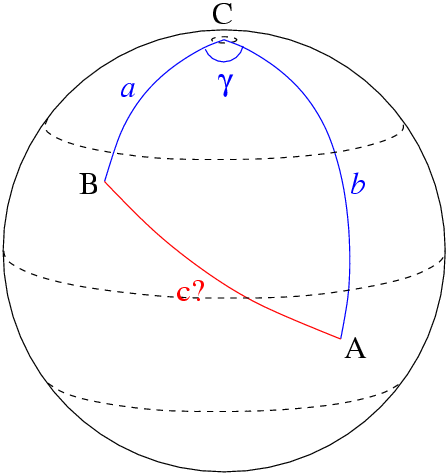 To calculate the distance between two points on the globe,
:Point A: latitude , longitude , and
:Point B: latitude , longitude
we consider the spherical triangle , where is the North Pole. Some characteristics are:
:
:
:
If two sides and the included angle given, we obtain from the formulas
:
Here is the
To calculate the distance between two points on the globe,
:Point A: latitude , longitude , and
:Point B: latitude , longitude
we consider the spherical triangle , where is the North Pole. Some characteristics are:
:
:
:
If two sides and the included angle given, we obtain from the formulas
:
Here is the Earth's radius
Earth radius (denoted as ''R''🜨 or R_E) is the distance from the center of Earth to a point on or near its surface. Approximating the figure of Earth by an Earth spheroid, the radius ranges from a maximum of nearly (equatorial radius, denot ...
.
See also
* Congruence
* Hansen's problem
* Hinge theorem
*Lénárt sphere
A Lénárt sphere is a educational manipulative and writing surface for exploring spherical geometry, invented by Hungarian István Lénárt as a modern replacement for a spherical blackboard. It can be used for visualizing the geometry of poin ...
*Snellius–Pothenot problem
The Snellius–Pothenot problem is a problem in planar surveying. Given three known points A, B and C, an observer at an unknown point P observes that the segment AC subtends an angle \alpha and the segment CB subtends an angle \beta; the problem ...
References
*{{cite book , author=Euclid , author-link=Euclid , editor=Sir Thomas Heath , editor-link=Thomas Little Heath , title=The Thirteen Books of the Elements. Volume I , others=Translated with introduction and commentary , publisher=Dover , year=1956 , orig-year=1925 , isbn=0-486-60088-2 , url-access=registration , url=https://archive.org/details/thirteenbooksofe00eucl
External links
Trigonometric Delights
by Eli Maor
Eli Maor (born 1937), an historian of mathematics, is the author of several books about the history of mathematics. Eli Maor received his PhD at the Technion – Israel Institute of Technology. He teaches the history of mathematics at Loyola Unive ...
, Princeton University Press, 1998. Ebook version, in PDF format, full text presented.
Trigonometry
by Alfred Monroe Kenyon and Louis Ingold, The Macmillan Company, 1914. In images, full text presented. Google book.
*
' on Math World.
Includes discussion of The Napier circle and Napier's rules
Spherical Trigonometry — for the use of colleges and schools
by I. Todhunter, M.A., F.R.S. Historical Math Monograph posted b
*
' – Triangle solver. Solve any plane triangle problem with the minimum of input data. Drawing of the solved triangle.
*
' – Free software to solve the spherical triangles, configurable to different practical applications and configured for gnomonic.
*
' – Solves spherical triangles.
*
TrianCal
' – Triangles solver by Jesus S.
Spherical trigonometry
Triangle problems
Trigonometry
de:Dreieck#Berechnung eines beliebigen Dreiecks
 The standard method of solving the problem is to use fundamental relations.
;
The standard method of solving the problem is to use fundamental relations.
; Let three side lengths be specified. To find the angles , the
Let three side lengths be specified. To find the angles , the  Here the lengths of sides and the angle between these sides are known. The third side can be determined from the law of cosines:
:
Now we use law of cosines to find the second angle:
:
Finally, .
Here the lengths of sides and the angle between these sides are known. The third side can be determined from the law of cosines:
:
Now we use law of cosines to find the second angle:
:
Finally, .

 This case is not solvable in all cases; a solution is guaranteed to be unique only if the side length adjacent to the angle is shorter than the other side length. Assume that two sides and the angle are known. The equation for the angle can be implied from the
This case is not solvable in all cases; a solution is guaranteed to be unique only if the side length adjacent to the angle is shorter than the other side length. Assume that two sides and the angle are known. The equation for the angle can be implied from the  The known characteristics are the side and the angles . The third angle .
Two unknown sides can be calculated from the law of sines:
:
or
:
:
The known characteristics are the side and the angles . The third angle .
Two unknown sides can be calculated from the law of sines:
:
or
:
:
 The general
The general 





 To calculate the distance between two points on the globe,
:Point A: latitude , longitude , and
:Point B: latitude , longitude
we consider the spherical triangle , where is the North Pole. Some characteristics are:
:
:
:
If two sides and the included angle given, we obtain from the formulas
:
Here is the
To calculate the distance between two points on the globe,
:Point A: latitude , longitude , and
:Point B: latitude , longitude
we consider the spherical triangle , where is the North Pole. Some characteristics are:
:
:
:
If two sides and the included angle given, we obtain from the formulas
:
Here is the